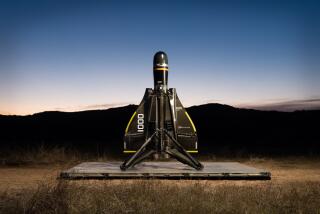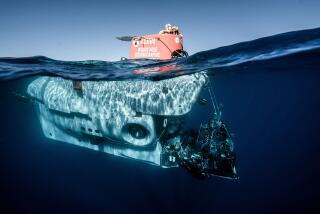Lockheed joins Boeing and General Dynamics in betting on ocean drones
- Share via
Lockheed Martin’s interest in a San Diego start-up shows how big aerospace companies are pushing the drone revolution out to sea.
Lockheed Martin Ventures last month invested an undisclosed amount in San Diego-based Ocean Aero — a 25-employee start-up that is developing the Submaran, a solar- and wind-powered ocean drone capable of operating above and below the surface.
“The ability to be environmentally powered allows us to maneuver at great persistence because it’s renewable,” said Eric Patten, chief executive of Ocean Aero and a former Navy officer. “And then to be able to transition that vehicle from the surface to a sub-surface vehicle that has significant capability under water, that is truly unique.”
Lockheed Martin Venture typically invests $1 million to $5 million in young companies.
“Ocean Aero represents the next generation of environmentally powered autonomous systems,” said Chris Moran, executive director of Lockheed Martin Ventures, in a statement. “Our investment will allow us to better respond to customers’ maritime needs with technology solutions for a diverse set of missions.”
Lockheed isn’t alone in betting on ocean drones. Last year, Boeing bought a Bay Area start-up, Liquid Robotics, which is developing unmanned submarine technology. General Dynamics and L3 Technologies also have acquired ocean unmanned systems firms over the last 18 months.
The U.S. military has plans to invest as much as $3 billion into undersea systems over the coming years, according to a report last year by the Washington Post.
“Blue tech for the maritime defense sector feels like where clean tech was a decade ago,” said Greg Murphy, executive director of the Maritime Alliance, a San Diego trade group for the blue tech industry. “There is momentum. The Navy is increasingly using autonomous systems, and the large defense contractors are starting to buy up smaller blue tech companies that are developing systems.”
Boeing and Lockheed recently were named finalists in the U.S. Navy’s Orca Extra-Large Unmanned Underwater vehicle project, which aims to develop big submersible drones capable of handling long-distance missions with significant payloads.
Ocean Aero is not part of Lockheed’s work on the Orca project. But the companies are working together more generally on underwater drone technology, said Patten.
Last year, Lockheed partnered with Ocean Aero for a technology demonstration at the Naval Undersea Warfare Center in Newport, R.I. A version of Ocean Aero’s Submaran patrolled the surface above a Lockheed undersea drone — the Marlin — providing communications gateway from the shore to the submerged vessel. The link between the shore and the Submaran used radio frequency technology; the link between the Submaran and the Marlin used acoustic communications.
“That communications gateway mission is critical for a ton of folks,” said Patten. “Defense is great use case, but commercial use cases are just the same. If you are operating a wind farm off the coast and you have things underneath the surface and you want to communicate with that equipment, there are only a couple of ways to do it.”
Ocean Aero, which is also backed by Teledyne Technologies, makes three different drones. Its S10 Submaran is a 14-foot-long craft with an 8-foot solar/wind wing. It can dive about 30 feet and glide underwater, and its rechargeable lithium batteries allow it to spend months at sea. It targets the research and commercial markets.
A sister vessel is the same size but can dive 660 feet and maneuver under the surface.
Ocean Aero’s big boat, called the Silent Aero, is 40 feet long, can dive 660 feet and carry a payload of 2,000 pounds.
About two years ago, Ocean Aero received a Department of Defense Rapid Innovation Fund grant to develop a hybrid unmanned underwater/surface vehicle that can travel long distances on the surface and then submerge to avoid surface traffic and conduct intelligence, surveillance and reconnaissance operations.
“In terms of robotics in the oceans, you can do things faster, cheaper and more efficiently,” said Murphy. “You can have robots out at sea collecting data, searching for things that shouldn’t be in the water and would present problems for the United States, or trying to find data where you want to have a covert operations.”
Freeman writes for the San Diego Union-Tribune.
More to Read
Inside the business of entertainment
The Wide Shot brings you news, analysis and insights on everything from streaming wars to production — and what it all means for the future.
You may occasionally receive promotional content from the Los Angeles Times.










